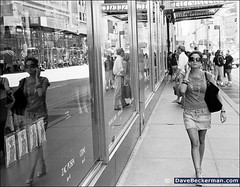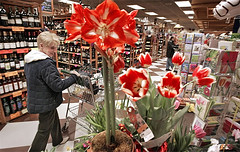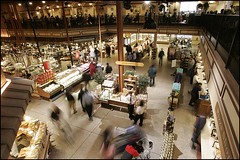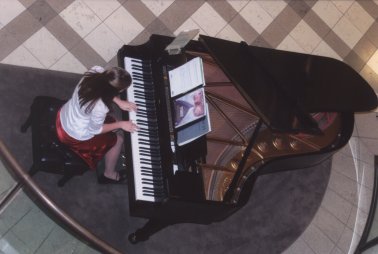Anchors away... and retail excitement, retail as theater
 Bloomingdales in Manhattan, NYC. Photo copyright by and available for purchase from Dave Beckerman.
Bloomingdales in Manhattan, NYC. Photo copyright by and available for purchase from Dave Beckerman. I've been arguing with one of the deans of retail consulting (Robert Gibbs) on an e-list. I actually have a great deal of respect for him, he's taught me a lot (via public presentation and the article "What Main Street Can Learn from the Mall," from Atlantic Monthly (1994), and we share some geographic heritage. He is in Birmingham, Michigan, which is the town that has survived the move to Shopping Malls, keeping an independent regional commercial district intact (because of the presence of two now dead regional department stores, Crowleys and Jacobsons) and before we could drive, we used to bike to Birmingham in the summers to hang out...
It's about restrictions on store sizes in urban areas, and it targets big boxes. It was touched off by this article from the San Francisco Chronicle, "Cities can keep out big stores: Court upholds law in Turlock designed to block Wal-Mart" and it has mutated into a discussion about the importance of anchor stores to commercial districts.
I am a big proponent of anchor "stores," recognizing that anchors in downtowns and neighborhood commercial districts can also be other types of destinations-attractions such as cultural venues (museums, performing arts), libraries, etc.
In fact I think that anchors are essential (or at least destination marketing drivers). However, all big boxes are not equally complementary and desirable anchors. Some store business models are specifically designed to crowd out other stores, to absorb and attract 100% of the retail dollar from the consumer--even if they don't fully succeed that is their aim. Sort of like how Roberto Goizueta said that he wanted 100% of the liquid drunk by consumers--the thing is he thought of this only in terms of Coke, not in terms of other beverages he could sell to us (and now Coke is getting its clocked cleaned by waters, teas, and other beverages).
In short, Walmart isn't the same kind of anchor as Bloomingdale's (more about Bloomies in a moment).
This is my latest missive on the subject:
I think you're glossing over a major scale change in what retail businesses attempt to accomplish. Something that Seth said awhile back jibes with the point I am trying to make.
(1) We can all accept that the scaling up of particular businesses within each category has occured.
(2) The point that I remember Seth making is that at some point, these sizes (think Bed, Bath & Beyond for example) are larger than what the business model of the shopping district is set up to accommodate.
(3) I think this has implications both for the commercial district;
(4) as well as the ability of other retail businesses to complement the "anchor" and
(5) whether or not the anchor intends that the customers it attracts are supposed to be able to patronize other establishments.
Accept that I say this as a proponent for center city commercial districts, and similar neighborhood and regional commercial districts of a Main Street type (e.g., Ann Arbor, Royal Oak, Ferndale, Birmingham, downtown Detroit, etc., in Michigan, not the malls).
You mention florist, coffee shop, and deli. Now, the 65,0000 s.f. to 130,000 s.f. supermarkets have all that in-house. There is no intention that you go outside of the grocery store to satisfy those needs. Wegmans has hundreds of seats for customers dine-in. The newest Whole Foods markets have extensive dining areas as well.
 Flowers, wine, and greeting cards at the supermarket. Milwaukee Journal-Sentinel photo.
Flowers, wine, and greeting cards at the supermarket. Milwaukee Journal-Sentinel photo.But a supermarket scaled for its commercial district, such as the 1,000,000 s.f. total of the H Street NE commercial district in DC could allow other businesses to survive and thrive. An example of an appropriately sized store in this context might be Fresh Market (growing rapidly), the new Sunflower Market concept from Supervalu, which tops out at 15,000 s.f., or maybe Fresh Grocer from Philadelphia.
 Note the upstairs seating at Wegmans. Photo: Mark Finkenstaedt, Washington Post.
Note the upstairs seating at Wegmans. Photo: Mark Finkenstaedt, Washington Post.Lest you think I am against anchors, which I am not and as I have said in the past Mr. Gibbs' presentation re-educated me to the value of subsidy for such formats on the part of cities, somehow I think that department stores are the killer app for center city commercial districts, both downtown and for the larger neighborhood commercial districts that have some regional destination aspects.
I wonder if JC Penney, Boscov, Beall's and the like could be enticed back to experiment with this. It's something I plan to study more when I go to grad school. But the stores would have to be more grand, theatrical, an experience, similar but on a different scale compared to Bloomingdales. Does Nordstrom's still have the grand piano and a player. Well maybe that's not Boscov's thing, but there are plenty of high school and college pianists out there with no work....
Now, speaking of grand, theatrical store experiences, the Retail Design Diva blog has an interesting piece about this in terms of a shopper newly introduced to the main Bloomingdales store in Manhattan. She wasn't impressed... she was out-wowed by other stores, and as I say time and time again "to stay the same is to fall behind, because your competitors are constantly moving forward, experimenting and changing." The entry is excellent in terms of understanding my point in terms of building "retail excitement" which has been what has distinguished "downtown stores" for more than 100 years--long before Pine and Gilmore wrote The Experience Economy.
 Student playing piano at Nordstroms. Image from Sint Sink Music.
Student playing piano at Nordstroms. Image from Sint Sink Music.Index Keywords: retail



0 Comments:
Post a Comment
<< Home